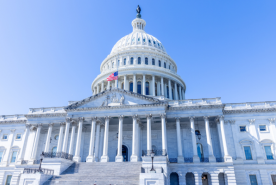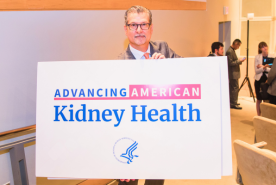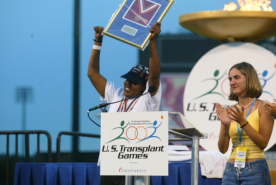March 13, 2023
<div><a href="https://www.kidney.org/newsletter/health-literacy-review-and-practical-… Lead Article – HEALTH LITERACY: A REVIEW AND PRACTICAL STRATEGIES</strong></a></div>
<p><em>Gloria Chen, LCSW-S, CCTSW<br>
Dell Seton Medical Center at The University of Texas at Austin</em>
</p>
<p>A national survey found that 36% of adults in the United States had inadequate health literacy skills to manage the demands of the healthcare system. Among patients with kidney disease, prevalence of limited health literacy has been found to be even higher with upward estimates at 49.6%.</p>
Gloria Chen, LCSW-S, CCTSW
Dell Seton Medical Center at The University of Texas at Austin
A national survey found that 36% of adults in the United States had inadequate health literacy skills to manage the demands of the healthcare system.1 Among patients with kidney disease, prevalence of limited health literacy has been found to be even higher with upward estimates at 49.6%.2
A systematic review conducted among patients with kidney disease found that limited health literacy is associated with hospitalizations, emergency department use, missed dialysis sessions, cardiovascular events, and mortality.3 Furthermore, the financial impact of limited health literacy has also proved costly to the healthcare system. One study of veterans demonstrated significantly increased healthcare costs for those with inadequate and marginal health literacy compared to those with adequate health literacy.4 Estimated 3-year healthcare costs associated with veterans with marginal and inadequate health literacy was $143 million more than those with adequate health literacy.4
According to Healthy People 2030, health literacy encompasses both personal and organizational responsibility to equitably enable individuals to “find, understand, and use information and services to inform health-related decisions and actions for themselves and others.”5 Health literacy has historically been viewed as an individual obligation, but has now been expanded to incorporate and acknowledge organizations’ responsibility to address health literacy.
In their adapted Health Literacy Model in Transplantation (HeaL-T), Chisholm-Burns et al. depicts the spectrum of factors and outcomes associated with health literacy in solid organ transplant recipients.6 Health literacy is influenced by several patient-level factors including age, race, language, education level, and patient’s verbal and cognitive function, etc., while also bidirectionally influences healthcare-level factors such as access and utilization of healthcare, provider-patient interaction, and self-management and adherence.
We see the impact of health literacy play out in our clinics when for example, a transplant patient arrives to his post-transplant follow-up visit presenting with no issues nor concerns. However, upon lab review, his Tacrolimus level is found undetectable. After further conversation with the patient, it is discovered that he has been taking his immunosuppressant medication incorrectly – confusing his 1mg capsules with his 5mg capsules. It is discovered at this time that despite having 8 years of education he is unable to read his medication list and has adapted by identifying his pills based on their color, shape, and size. This strategy has worked for him throughout his life until he received a transplant at which point, he became overwhelmed with a lot more medications than he has ever been used to. A couple of months later, the patient again makes another medication error due to an unfortunate medication manufacturer change. This mistake proves costly as he gets admitted to the hospital for a kidney biopsy and subsequent rejection treatment that costs him a 7-day hospitalization. The patient’s limited health literacy was influenced by his education level which then led to subsequent healthcare resource utilization costs related to his hospital admission. Health literacy is a dynamic factor that touches all points of healthcare from patient to provider and the entire healthcare system. Solutions to properly address health literacy thus require inclusion at all levels.
Health literacy universal precautions proposes that given the prevalence of limited health literacy, all patients should be approached with the assumption that they are at risk of not understanding health information.7 Health literacy universal precaution strategies are aimed to help providers and health care organizations improve and incorporate health literacy tools into their practice. Practical strategies for healthcare systems and providers proposed through health literacy universal precautions include7:
- Form a health literacy leadership team that is represented by both clinical and administrative staff tasked to plan and implement health literacy-related changes. Assess the organization’s health literacy and create a health literacy improvement plan.
- Create a welcoming, inviting, and friendly environment to help decrease patient anxiety and allow patients to feel more relaxed and willing to engage and participate in care.
- Assess the forms and written materials provided in your practice. Selecting and creating easy to read material can help improve patient comprehension.
- Use plain, nonmedical language and incorporate the patient’s words into your conversation. Slow down and speak at a moderate pace. Repeat content and be specific and concrete.
- Demonstrate recommendations to supplement verbal communication, which may help improve patient’s understanding (e.g. demonstrate how to organize a pillbox or a form of recommended exercise).
- Utilize the teach-back method to confirm patient understanding of the information provided by asking the patient to teach back important information.
- Conduct medication reviews at each patient visit by requesting patients to bring all their medication bottles to their appointment and review each one with them with the goal of determining what and how the patient is taking their medication.
- Create action plans in collaboration with the patient at the end of the visit to help engage patients in their treatment plan and breakdown goals into manageable, concrete steps.
Limited health literacy is prevalent among the chronic and end stage kidney disease patient population. Strategies to more equitably enable individuals to make informed healthcare decisions are important to incorporate into organizational and clinical practice.
References
1. Kutner M, Greenberg E, Jin Y, Paulsen C. The Health Literacy of America’s Adults: Results from the 2003 National Assessment of Adult Literacy. National Center for Education Statistics; 2006.
2. Taylor DM, Fraser SDS, Bradley JA, et al. A Systematic Review of the Prevalence and Associations of Limited Health Literacy in CKD. CJASN. 2017;12(7):1070-1084. doi:10.2215/CJN.12921216
3. Taylor DM, Fraser S, Dudley C, et al. Health literacy and patient outcomes in chronic kidney disease: a systematic review. Nephrology Dialysis Transplantation. Published online November 20, 2017. doi:10.1093/ndt/gfx293
4. Haun JN, Patel NR, French DD, Campbell RR, Bradham DD, Lapcevic WA. Association between health literacy and medical care costs in an integrated healthcare system: a regional population based study. BMC Health Serv Res. 2015;15(1):249. doi:10.1186/s12913-015-0887-z
5. U.S. Department of Health and Human Services Office of Disease Prevention and Health Promotion. Health Literacy in Healthy People 2030. https://health.gov/healthypeople/priority-areas/health-literacy-healthy-people-2030
6. Chisholm-Burns MA, Spivey CA, Pickett LR. Health literacy in solid-organ transplantation: a model to improve understanding. PPA. 2018;Volume 12:2325-2338. doi:10.2147/PPA.S183092
7. Brega A, Barnard J, Mabachi N, et al. Health Literacy Universal Precautions Toolkit, Second Edition. Published online January 2015.







